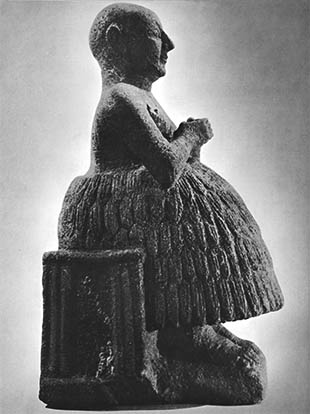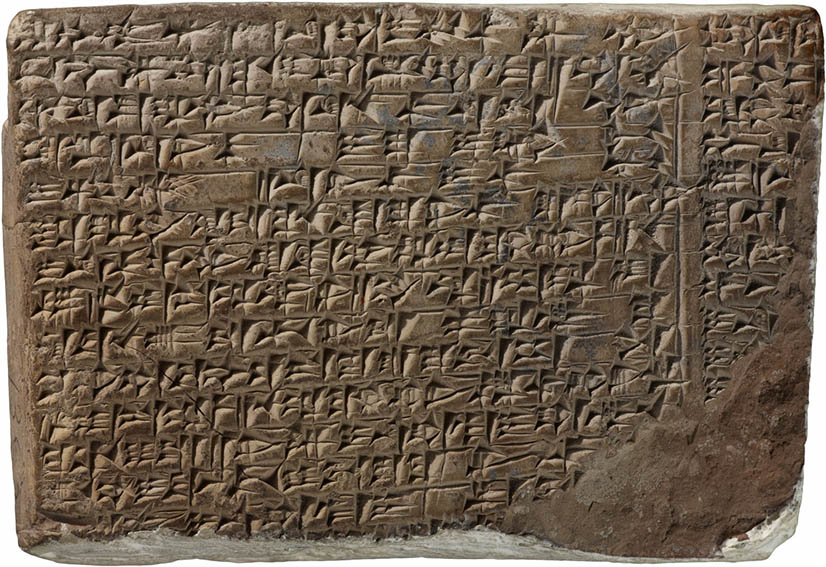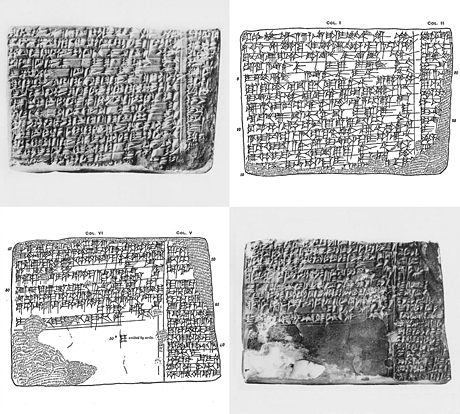1
The Legend of Etana
Sumerian Cuneiform
This Akkadian clay tablet,1 ca.1900–1600 BC,2 contains a partial version of the ancient Sumerian Legend of Etana written in cuneiform. According to the Sumerian King List, Etana, the King of Kish or the Shepherd King, was one of the first rulers after the Great Deluge and his reign lasted either 635 or 1560 years. In the attenuated version of the story Etana attempts to fly with an eagle to the heavens to meet the sky-god Anu who can show him where to find the plant of birth, allowing Etana to father a son. In some versions he is successful, in other he falls back to Earth. But, again consulting the King List, the next ruler of Sumeria was Balih, the son of Etana, so make of this what you will.
From ref. 1
By the end of the fourth millennium BC, or more specifically around 3200 BC, the first written script, cuneiform, appeared in Mesopotamia. Sumerian legend has it that writing was invented by the god Enmerkar, but Denise Schmandt-Besserat fairly ruins this story by arguing that writing evolved out of the use of clay tokens and envelopes (bulla) used for bookkeeping.3 Impressions of tokens into wet clay bulla evolved into simple pictograms that represented specific objects. Around 2700 BC the Sumerians began using these pictograms not just to describe objects but to describe sounds and by combining these signs it was now possible to write any word, or as linguists say “and and all thought.” This rebus principle was the true basis for written language.4

Sumerian scribe, ca.2500 BC.
The pictograms went through a number of transformations and by 2500 BC Sumerian scribes had reduced the script to only five basic wedge-shaped strokes impressed into clay tablets with a triangular shaped reed stylus, hence the name cuneiform (L: cuneus “wedge”).5 These five basic signs were, in turn, combined into even more complex logograms or ligatures, some requiring as many as 30 separate impressions:


Over the centuries many civilizations rose and fell in the Fertile Crescent and many adopted cuneiform for their language. The Sumerians, the Akkadians, the Babylonians, the Assyrians, the Hittites and the Hurrians all wrote in cuneiform and left behind some of the earliest examples of literate societies. The Epic of Gilgamesh (2700 BC) was perhaps the first literary work in history. Enheduanna’s hymns (2250 BC) were the first works by a known author. The Code of Hammurabi (1760 BC) was the first codification of law. The Armana letters (1400 BC), were the first examples of diplomatic correspondence. The list goes on, but you get the idea.
The use of cuneiform declined after the rise of Aramaic around 600 BC and was completely gone by the first century AD. Of course, it didn’t take long for all knowledge of cuneiform to be lost, and by the middle ages the script appeared to be inscrutable. Sir Thomas Herbert, in the 1664 edition of his book, A Relation of some Yeares Travaile, was the first to suggest that these signs from Persepolis were ‘legible and intelligible,’ but it would be almost 200 more years until another Englishmen, Sir Henry Rawlinsen, began a serious decipherment. Rawlinsen studied the Behistun Inscription in Iran, and by 1851 he could read 200 cuneiform signs. In 1857 Rawlinsen, Edward Hincks, Julious Oppert, and William Henry Fox Talbot took part in the famous Royal Asiatic Society experiment. They each deciphered a newly-discovered Assyrian text and their results were so similar that the decipherment of cuneiform, at least Akkadian cuneiform, was considered complete.
1. From: Clay, Albert. A Hebrew Deluge Story in Cuneiform, and other Epic Fragments in the Pierpont Morgan Library. New Haven: Yale University Press, 1923.
2. The practice of dates based on Jesus’ birth was introduced in 525 by the monk Dionysius Exiguus, who named it “anno Domini” (L: [in] the year of our Lord). Two centuries later the historian St. Bede identified dates before Jesus’ birth with Latin phrase “ante incarnationis dominicae tempus” (”the time before the Lord’s incarnation”, or simply “before Christ”), hence BC and AD. By the late 1800s the terms BCE (before the common era) and CE (common era) began to be used as more generic and neutral terms. Although your humble author is tolerant and sensitive of other cultures and world-views, he is only to a certain point: BC and AD it is.
3. So think accountants and mid-level bureaucrats, not legendary gods. Sad, but true. See: Schmandt-Besserat, Denise. “Signs of Life.” Odyssey Jan 2002, or better yet, Schmandt-Besserat, Denise. How Writing Came About. Austin, Texas: University of Texas Press, 1996. Some 90% of early cuneiform texts are administrative in nature.
4. E.g.: the Sumerian word for fish is a-dar-tunku6 and is made up of a (water) + dar (to slice) + tunku6 (to smash). Modern day examples of a rebus would include the game show (and board game) Concentration, or Paul Rand’s IBM poster, or beer bottle caps. Sometime around 1977 a number of beer brands owned by S&P, such as Ballentines, Falstaff, Lone Star, Olympia, and Ranier, began including rebuses on the bottle caps as a puzzle. Presumably the more beer you drank the more challenging the puzzles became. Here are a few from Ranier Beer:

To bring this full circle it should be noted that beer was invented (or, more likely, discovered) by the Sumerians ca.9,000 BC. The Epic of Gilgamesh includes references to Siduri, a brewster and barmaid, and the Hymn to Ninkasi (the goddess of beer), ca.1800 BC, includes the earliest known recipe for beer. So important were the ancient brewers that they were exempted from military service.
5. For more than you probably care to know about the subject, see the Cuneiform Digital Library Initiative.
6 Nov 2008, updated 28 Dec 2011 ‧ Typographia Historia

